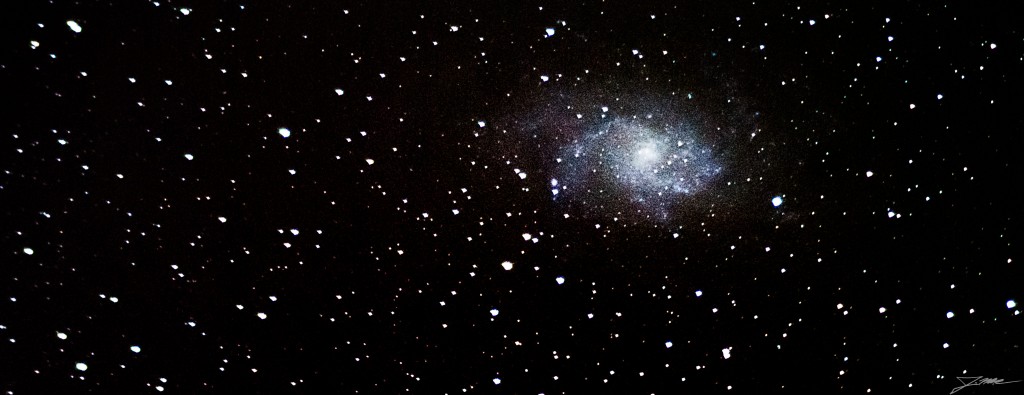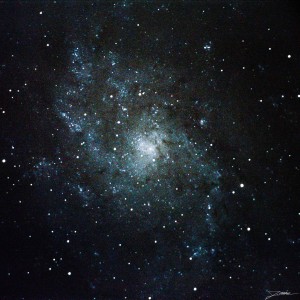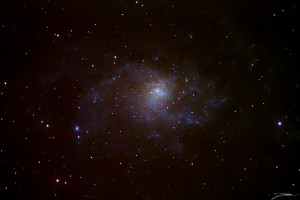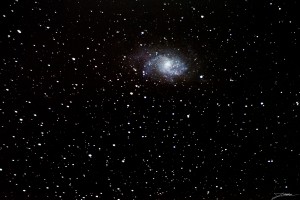
If a thing is worth doing, it’s worth doing right. Trying to image through a 1.25″ eyepiece adapter and 90° mirror diagonal is not the best plan. I did so, and while I was able to capture more images because the diagonal clears the mount while the area of the sky being imaged is overhead, the resulting images were less saturated than I wanted. It also caused the image to be flipped vertically, which I forgot to correct before posting the image. D’oh! First attempt at M33 (Pinwheel galaxy), and I wanted to image while it was as high in the sky as possible. What I should REALLY do is get off my lazy butt and build the DIY equatorial wedge I’ve been thinking about…
In any case, here’s a stack of 64 lights, 10 darks, 10 bias frames, and NO flats, since I haven’t been able to get those to play nicely. 32 minutes of integration (64x 30-second exposures) through the NexStar 8 GPS (2032mm, f/10) with the T1i at ISO 6400:

Not bad. I think I missed the focus by a smidge because my other deep sky images don’t have quite as much blooming around the stars. Not satisfied, I figured out when astronomical twilight ended on Saturday night, and had the scope set up just after sunset so I could image further from zenith, and with the focal reducer in place. It doesn’t cause the diagonal to foul the mount, but there’s not enough focuser travel to get the camera in-focus when looking through the diagonal and eyepiece adapter. So, with the setup all ready to go, I managed to catch 46 images before the camera base was going to hit the scope base during the next 30 seconds. I actually nabbed 66, but the first 20 had out-of-focus tree branches in the way. I also grabbed 20 darks, bias, and flats, but still had to chuck the flats because apparently I’m still not using a bright enough or even enough light for them to work correctly. In any case, with some high-pass filter and color layering in Photoshop, I was able to come up with the following:

Without the ability to image through the main scope anymore, I thought I’d try imaging through the Travelscope riding piggyback. I recently took the scope apart, blackened the edges of the lenses (to reduce internal reflections) and cleaned up a spot in between them. I set the intervalometer for 75 images, and went back inside. Unfortunately, after about 30 shots, the front lens element fogged up, and the rest were unusable. However, with 30 stacked 30-second, 400mm, f/5.71, ISO 6400 images, a reasonable amount of detail can still be seen:

Since the signal-to-noise ratio (SNR) is related to the square root of the number of frames, I’d need to quadruple the number of frames shot to double my SNR. So, from 46, that’d mean I’d need another 138 frames for a really noticeable increase in detail… But since I’m already maxed out for shots I can take before the camera fouls the mount… I’d need three more good shooting nights to get this done. Or… I need to get that equatorial wedge sorted out so I can lower my ISO and shoot longer exposures. Since I’m not nearly blowing out the individual shots here, I could theoretically shoot longer exposures at the same ISO before running into too many of the pixels being ‘full’, but since my camera does MUCH better at lower ISO than all the way up at 6400, I’d gain a big jump in SNR by lowering ISO, even with identically ‘exposed’ single frames.

Leave a Reply